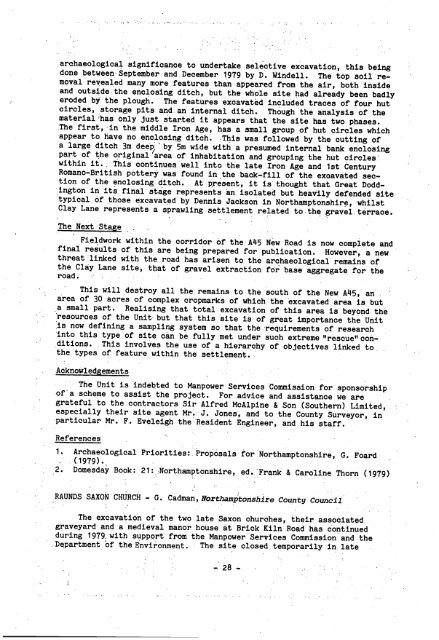Untitled - Council for British Archaeology
Untitled - Council for British Archaeology
Untitled - Council for British Archaeology
You also want an ePaper? Increase the reach of your titles
YUMPU automatically turns print PDFs into web optimized ePapers that Google loves.
'<br />
This<br />
:archaeological significance to undertake selective excavation, this being<br />
done between-September and.December 1979 by D. Windell. The top soil removal<br />
revealed many moreteatures than appeared from the air, both inside<br />
and outside.the enclosing ditch, but the whole site had already been badly<br />
eroded bY the plough. The features excavated included traces of four hut<br />
circles, storage pits and.an internai ditch. ThOugh the analysis of the<br />
materialhas Only just atarted it appears that'the site has two phases.<br />
The first,.in the middle Iron Age, has a small group of hut circles which<br />
appear to have no énclOsing ditch. This was followed by the cutting of<br />
a large ditch 3m deep''by 5m wide with a presumed internal bank enclosing<br />
part of the original/area of inhabitation and grouping the hut circles'<br />
within it.. This continues:well int6 the late Iron Age and 1st dentury<br />
Romano-<strong>British</strong> potterY Was found in the.back-fill of the excavated section<br />
of the enclosing-ditch. At present, it is-thought that Great Dodd-<br />
'ington inita final stage represents an isolated but heavily defended site<br />
typical Of those eXcavated by Dennis. Jackson in Northamptonshire, whilst<br />
Clay Lane represents a sprawling settlement related to-the gravelotérrace.<br />
The Next Stage<br />
FieldwOrk within the corridor Of the A45 New Road is now complete and<br />
final retults of this are being prepared <strong>for</strong> publication. However, a new<br />
threat'linked with the road has ariSen to the archaeological remains of<br />
the Clay Lane site, that of gravel extraction fcir base aggregate <strong>for</strong> the<br />
road.<br />
will destroy all the remains tothe south of the New A45, an .<br />
area of 30 Acres of complex cropmarks of which'the excavated area is but<br />
.a small part. Realising that total excavation of.this area is beyond thé<br />
resources of the Unit but that this site ia of great importance the Unit<br />
is now defining a sampling system so that the requirements of research<br />
into this type of site can be fully met under sUch extreme "réscue"con-<br />
.ditions. .This involVes the use of a hierarchy of objectives linked to,<br />
the types of feature within the settlement.<br />
Acknowledgements<br />
The Unit is indebted to Manpower Services Commission <strong>for</strong> sponsorship<br />
ora scheme to assist the project. For advice and assistance we are<br />
grateful to the contractors Sir Alfred McAlpine & Son (Southern) Limited,<br />
especially their site agent Mr. J. Jones, and to the County Surveyor, in<br />
particular Mr. F. Eveleigh the Resident Engineer, and his staff.<br />
References<br />
Archaeological Priorities: Proposals <strong>for</strong> Northamptonshire, G. Foard<br />
_ (1979).<br />
DomesdaY Book: 21: Northamptonshire, ed. Frank & Caroline Thorn (1979)<br />
RAUNDS SAXON CHURCH - G. Cadman,Morthamponshire County <strong>Council</strong>,<br />
The excavation of the two late Saxon churches, their associated<br />
graveyard and a medieval manor house at Brick Kiln Road has Continued<br />
during 1979, with support from the Manpower 'Services Commission and the<br />
:Department of the invironment.. The site closed temporarily in late .<br />
- 28 -

















